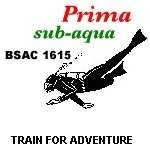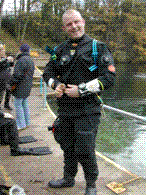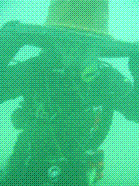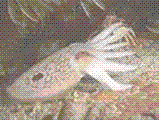
Issue 3 February 2007
Off-Gassing...
(Web Version)
Welcome to the third issue of our newsletter.
There will be a DIVERS FORUM on the Tuesday 3rd
April, at the Woodman Pub. Why not come along and make your views known?
Everyone attending will get a raffle ticket, you could win a mystery
prize.
A reminder from the Membership Secretary:- BSAC fees due 1st March 2007.
Remember, you are invited to contribute to the newsletter anything you
think may be of interest.
Our congratulations go to Salli and Jason who were married on Monday
29th January.
Profile:- Phil Kinsman, Diving Officer
The
Rez - Stoke
10th February
. Capernwray - Up North
24th February
NDAC -- Chepstow
10th March
MURDER MYSTERY
WEEKENDS
Please let us know if you are interested. Would probably sometime in
September 2007. Open to over 16’s only.
.
Phil started diving in 1996, with PADI, while on holiday in Thailand.
Phil was working in Hong Kong at the time so was ideally placed for some
fantastic diving in Hong Kong, Philippines and Sipidan. As well as
leisure diving Phil also completed extended range and cave diving.
Whilst in HK Phil continued to the level of dive master, then it was
back to “blighty” for some cold water diving!!
Phil joined BSAC and then looked for a local club with friendly,
approachable people….PRIMA. It was a bit of a baptism of fire after HK -
Phil’s first dive with PRIMA was in Blithfield in a 3mm wetsuit!
Blithfield in a 3mm wetsuit!
Armed with a dry-suit Phil continued diving and did his snorkelling
instructor exam under the guidance of Al, then followed his advanced
diver and open water instructor, then the fateful day arrived when Phil
was “cornered” by Aggy and Al and asked if he would like to be the new
D.O!
Phil has enjoyed his reign so far. His favourite moments include the
dive planning & marshalling course, and looks forward to many more dives
with PRIMA, the club he describes as “probably the best dive club in the
world”
Advice – dive all year round, it makes you a better diver.
Cock-ups – too many to mention, but haven’t won the Brass Ass
National Dive & Activity Centre Chepstow
10 litre Cylinder. In test
£50 contact: Richard Mace
0121 232 6007
If you have any items for sale please let us know.
If you have not visited the
National Dive Centre you have missed a treat. The diving area as a lot
to offer in the way of attractions, depth and visibility.
When you arrive, there is a large car park, excellent amenities
including changing rooms. Hot
 food
and drinks. Its not over crowded and only takes 1.1/2 hours to get
there. You board either a jeep or van that transports you and your kit
down to the pontoons and back, just sit back and enjoy the ride.
Attractions under water include, Amphibious Vehicle, Devon Aircraft,
Troop carrier and swim throughs, and many more with a depth range from
0—80 metres. They are at present awaiting the arrival of a Jetstream
Aircraft.
food
and drinks. Its not over crowded and only takes 1.1/2 hours to get
there. You board either a jeep or van that transports you and your kit
down to the pontoons and back, just sit back and enjoy the ride.
Attractions under water include, Amphibious Vehicle, Devon Aircraft,
Troop carrier and swim throughs, and many more with a depth range from
0—80 metres. They are at present awaiting the arrival of a Jetstream
Aircraft.
If you want to learn more visit their website at www.ndac.co.uk
The club’s next visit will be on the dive plan, early summer. Try not to
miss it, it’s a good day out.
Photo: Chris at NDAC
Animal of the Month
Editors Corner
Thank you to everyone who has contributed to this months issue, and
apologies for any mistakes.
Any further articles for next months edition would be appreciated, (any gossip, scandals, etc that’s printable) so let us know by 20th February.
Hope you enjoyed this issue.
Sepia officinalis - Cuttlefish
The European or common cuttlefish, Sepia officinalis reaches a maximum
length of 45 cm, although one individual has been recorded at 60 cm. The
mantle (main body area above the eyes) houses the cuttlebone,
reproductive organs, and digestive organs. A pair of flat fins span the
entire length of it, and undulate when the cuttlefish swim. The head is
located at the base of the mantle with a beaklike jaw in the centre. The
jaws are encircled by eight pairs of arms and two longer tentacles that
can be retracted completely into the body.
 Cuttlefish
can change colour due to structures contained within its skin,
which are filled with coloured ink which can be expanded and contracted
to communicate with others or as camouflage against the landscape. These
structures allow the cuttlefish to display numerous colours, and even
change the texture of their skin.
Cuttlefish
can change colour due to structures contained within its skin,
which are filled with coloured ink which can be expanded and contracted
to communicate with others or as camouflage against the landscape. These
structures allow the cuttlefish to display numerous colours, and even
change the texture of their skin.
The blood of a cuttlefish is an unusual shade of green-blue because it
uses the copper-containing protein haemocyanin to carry oxygen instead
of the red iron-containing protein haemoglobin that is found in mammals.
The blood is pumped by three separate hearts, two of which are used for
pumping blood to the cuttlefish's pair of gills (one heart for each
gill), and the third for pumping blood around the rest of the body.
The name Sepia refers to the type of ink it houses within its body. This
ink is used to deceive large predators when they try to attack the
cuttlefish. When a predator is near, the ink is shot out into the water
to confuse the predator, while the cuttlefish swims to safety.
Cuttlefish (Sepiida) are in an Order of molluscs that possess an
internal shell called the cuttlebone. The cuttlebone is made of
calcium carbonate and plays a dominant role in these molluscs' buoyancy;
it is divided into tiny chambers in which the cuttlefish can fill or
empty of gas, depending on its needs. They are in the Class Cephalopoda
which is the group that contains cuttlefish, octopuses, squid and the
chambered nautilus.
The Cuttlefish, Sepia officinalis, has been found in the Mediterranean,
North and Baltic Seas. They are found in sub littoral depths, at around
200 m.
The camouflage of the Cuttlefish allow it to blend itself perfectly into
the background, so it sneaks up on prey and shoots out its two long
tentacles at lightning speed. It uses the suckers on these tentacles to
hold its prey and bring it back towards its beak. The Cuttlefish eats
crustaceans and fishes. Its primary predators are large fish like
sharks, monkfish and swordfish. They are caught for food in
Mediterranean, and East Asian cultures. Although squid is more popular
as a restaurant dish all over the world, in East Asia dried cuttlefish
is a highly popular convenience snack food